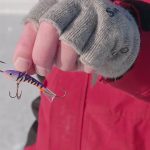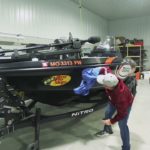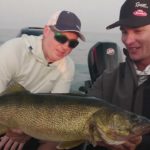Cold Fronts and Muskies
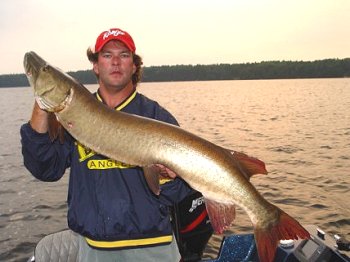 Cold fronts, just mentioning these two words make most fishermen shiver. Not just because the weather is going to get cooler, but because of the effects from these ever popular weather anomalies pose on the targeted fish of choice. Being a guide, I have to fish with clients rain or shine, hot or cold, and cold front or not. Learning how to deal with these changes in weather wasn’t easy, but there are definitely ways around the brutal cold fronts.
Cold fronts, just mentioning these two words make most fishermen shiver. Not just because the weather is going to get cooler, but because of the effects from these ever popular weather anomalies pose on the targeted fish of choice. Being a guide, I have to fish with clients rain or shine, hot or cold, and cold front or not. Learning how to deal with these changes in weather wasn’t easy, but there are definitely ways around the brutal cold fronts.
UNDERSTAND COLD FRONTS
First of all, cold fronts are generally misunderstood. They aren’t always bad. They don’t affect every kind of fish in the same manor and certainly don’t affect muskies the same way they would a bluegill. Cold fronts can actually be a good thing. For a cold front to occur, an obvious change in weather has to happen. Any change in weather is a very positive situation for a muskie fishermen. Periods of hot flat weather usually spark some kind of approaching storm. Wind currents will pick up, humidity levels will change, and barometric pressure will drop from the dreadful steady 30 inch mark. All of these changes will get muskies moving and kick in their feeding instincts. Most muskie fishermen watch the weather for these kind of changes and plan their days attack accordingly. Experienced fishers will be on their best big fish locations prior to a storm and be throwing their best confidence lures. Usually during these kind of changes, musky catches are high and some big fish have been reported caught or for surely seen “following.” Predicting muskie catches prior to storm fronts is easy, especially if there hasn’t been any change in weather for a week or two. If there has been several cells moving through the area every 3 or 4 days, predicting the big feed will still happen prior the actual storm, but generally the activity isn’t as intense with multiple fronts as it is with a single front. The day of the actual front will bring heavy skies, rain, and variable amounts of wind. All of these conditions will spark an extended amount of muskie activity due to the long day of low light conditions.
AFTER THE FRONT HAS PASSED
 Once the weather front has passed, Mother Nature leaves us will high, bluebird skies, and various amounts of North or Northwest winds. The air has a clean, cool crispness to it and fishing activity has definitely slowed down. The whole food chain is affected. Flies and mosquitoes aren’t as active, baitfish aren’t as high in the water column, and muskies are usually harder to locate. They are harder to locate because most musky fishermen are still looking for them in the same places they found them 1 to 2 days prior to the front passing. Many reports of muskies not moving are heard throughout the local baitshops. Well, these fish didn’t up and leave the lake, they just changed their locations.
Once the weather front has passed, Mother Nature leaves us will high, bluebird skies, and various amounts of North or Northwest winds. The air has a clean, cool crispness to it and fishing activity has definitely slowed down. The whole food chain is affected. Flies and mosquitoes aren’t as active, baitfish aren’t as high in the water column, and muskies are usually harder to locate. They are harder to locate because most musky fishermen are still looking for them in the same places they found them 1 to 2 days prior to the front passing. Many reports of muskies not moving are heard throughout the local baitshops. Well, these fish didn’t up and leave the lake, they just changed their locations.
AREAS TO TARGET AFTER THE FRONT
Muskies will move to 1 to 2 different locations after a major cold front. These two locations are thick, slop weed cover or suspend in open water. After the Summer of 2004, or maybe called by some as the reoccurring cold fronts of 2004, I had plenty of opportunity to test these locations time and time again. Most normal weed edges or flats are abandoned that spring to summer period muskies use to feed on in favor of thick patches of shallow cabbage or coontail beds. If your favorite lake doesn’t contain either one of these weed types, any type of weed growth will work as long as it is thick. If there isn’t shallow thick slop available, the muskies will move out and suspend over open water. Most of the muskies that are using these areas will be in a neutral to negative mood, however moods can change throughout the day. A lot of the lakes in my area(Vilas County,WI) are gin clear lakes that have several good areas of heavy thick weed cover located in shallow areas of each respecting lake. Believe me, I tested this approach on several different lakes, and it held consistent on every one of them. The only down fall to clear water on sunny high sky days is that the midday fishing is often very slow. Darker water lakes offer some relief to penetrating rays from the large orb in the sky. The clear lakes will always have a peak bite at low light times, either early morning, or more intensively last light or after dark. Therefore, to be the best Esox Angler that you can be, I would start the day on a clear lake, switch to a stained lake during the day, and then switch back to a clear lake for the evening and/or night bite. I have a body of water that I frequent often that offers steep wooded shorelines and combined with a slightly stained water. This combo can be very good during the dreaded day after the cold front. I spent a lot of days doing this last spring and summer, if made for some long days, but it usually paid off.
HOW TO ROOT THEM OUT OF THE COVER
When the muskies move into the shallow heavy cover, I mean they move into the shallow heavy cover, usually right into the heart of the thickest weeds! Working lures through this stuff can be a chore. However, with proper lure selection, it can be done very easily. With dealing with negative to neutral muskies, a triggering style of retrieve is needed to get them to open their mouths. Jerkbaits are a great way to work through weeds that allow avenues to steer the lure around the heavy cover. Suicks, Bobbies, and Burts can easily be worked in and around these type of weeds. Contacting individual stalks of cabbage and allowing the lure to rise up and backwards makes it easy to steer the lure around the plant and move to the next one. The contacting of cover is also a great way to get a muskie’s attention and get her to strike. I don’t think downsizing is important here, because most strikes are reaction and the muskie has very little time to think about the size 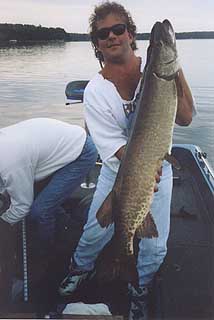 of the snack that they are about to have. Another approach that works good is using a spinnerbait to work through the weeds. Grinders, Rad Dogs, and Lindy M & G’s are great for doing this. This type of lures are very weedless and offer the option of straight retrieving them over the weeds and bulging them back to the boat after the lure has cleared the weeds. A jigging motion worked through a heavy cabbage patch coupled with a ripping motion as the spinnerbait is cleared of debris is often the deadly combination to root out a inactive musky and turn them into an angry musky. A longer 7’6″ to 8′ foot rod of your choice is preferred here. Picking up line and steering lures is aided with a longer stick.
of the snack that they are about to have. Another approach that works good is using a spinnerbait to work through the weeds. Grinders, Rad Dogs, and Lindy M & G’s are great for doing this. This type of lures are very weedless and offer the option of straight retrieving them over the weeds and bulging them back to the boat after the lure has cleared the weeds. A jigging motion worked through a heavy cabbage patch coupled with a ripping motion as the spinnerbait is cleared of debris is often the deadly combination to root out a inactive musky and turn them into an angry musky. A longer 7’6″ to 8′ foot rod of your choice is preferred here. Picking up line and steering lures is aided with a longer stick.
DEALING WITH SUSPENDED FISH
If the shallow style of cover isn’t available or efforts have good unrewarded, casting open water or trolling(where legal) is the next best option to try. I can’t troll in my area, so casting is my only option. I generally position my Ranger off of structure 1 or 2 cast lengths and probe the area around it. Structure may be a weed hump, rock bar, or secondary break from a normally productive weed line. These fish will be generally hold a little deeper than normal after the effects of the recent cold front. There doesn’t always have to be baitfish around to have a muskie using open water. It’s simple, if the muskies aren’t in the mid lake cover that they were in recently, they are probably a few tail kicks out and away. This is time to cover water, spread lures on both sides of the boat and make long casts. I usually like to cover the water column and then see what the fish want. I like to throw deep divers and large plastics. 10 inch Jakes, Ernies, and Depth Raiders are my favorite cranks for getting at them. Obviously the Ernies and Depth Raiders will get deeper, and the Jake is considered the shallowest bait here. For plastics, Bull Dawgs and Twin Fins are my most productive hands down. Once I see action from a certain depth, my clients and I will concentrate on that depth range and work lures that cover that depth the most efficient way. Heavy spinnerbaits such as Shumway’s Funky Chicken can be worked at any depth. These are very effective slow rolled back to boat and ripped upward at the last couple cranks of the cast. Cover the water column and try a variety of lures.
LIGHTS OUT: NIGHT BITE TIME
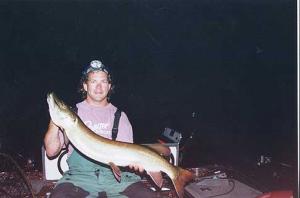 Without trying to make this a night article, I’ll touch a little on the night bite during a cold front. On clear lakes after a front, if there is no action during the day, there will be a small intense window of activity during last light or just after dark. This occurs as the tight lipped muskies move out of the thick cover and set up on the nearby weed edge. Cover these edges with loud cranks or jerkbaits such as jointed Depth Raiders or weight Burts is the deadliest way I know how. Parallel the edge coming in contact every now and then with the lure. Rip the lure hard when it encounters debris and allow it clean itself and hold on. This contacting structure works the same way the jerkbait does during the daytime. I have caught countless muskies doing this after dark, especially when dealing with cold fronts.
Without trying to make this a night article, I’ll touch a little on the night bite during a cold front. On clear lakes after a front, if there is no action during the day, there will be a small intense window of activity during last light or just after dark. This occurs as the tight lipped muskies move out of the thick cover and set up on the nearby weed edge. Cover these edges with loud cranks or jerkbaits such as jointed Depth Raiders or weight Burts is the deadliest way I know how. Parallel the edge coming in contact every now and then with the lure. Rip the lure hard when it encounters debris and allow it clean itself and hold on. This contacting structure works the same way the jerkbait does during the daytime. I have caught countless muskies doing this after dark, especially when dealing with cold fronts.
DEALING WITH COLD FRONTS IN THE FALL
Cold fronts happen in my neck of woods more often in the Fall then any other time of the year. Therefore, I feel that muskies are much more easy to predict during cold fronts during the Fall than any other time of the year. Fall is usually a feast or famine time of year anyway, and many muskie fishermen will famine during a cold front day because the action is slower than normal and call the day early. This is when the 11th hour becomes the hot time of the day. If there is ever a time when muskies turn on for a short time and can be predictable, it is in the Fall after turnover during a cold front right before dark. Believe me, it works. Most people don’t take advantage of this because it is hard to keep chins up when nothing is moving all day long. That last hour of the day can make all the previous hours disappear in a hurry when a huge flurry of activity takes place. I usually start my guiding day around 9 am in the Fall and fish until dark anyway. I believe that there is always a feeding window sometime during the day in the Fall, however under normal conditions it is hard to predict. Being on the water all hours of the day allow my boat to usually encounter the window. I don’t think that being out at the crack of dawn is necessary, therefore the 9 am start. However, during a cold front day, I have logged most of my fish anywhere from 1 to 1.5 hours prior to dark and right up until total darkness. Most guys leave the water around then and call the day and swear at the cold front that settled over head. If I have had no activity all day long, I make sure that my boat is at the spot on the spot best big fish structure the lake has to offer during the last hour of light. This produced a heavy 48 incher for a client of mine 2 years ago after nothing happened all day long. Take the time and fish the whole day through during a cold front day in the fall. You may get lucky and catch one during the day, it happens no doubt, but it nothing happens during the day, the last hour will reward you!
AREAS TO KEY ON
I usually key on lakes that have cisco forage bases in the Fall. Steep breaking shorelines laced with cribs or natural brush structures or deep weed edges that are still green are great placed to be right before dark. The steep gravel shorelines are key areas for ciscoes to spawn, and the low light conditions draw these high protein baitfish to these shallow locations. Muskies are opportunistic feeders and will follow these baitfish and have themselves a little feast. Cover each structure parallel either with deep diving cranks or heavy jerkbaits and keep a lively sucker on a quick-strike rig over the side of the boat. It isn’t uncommon to have a 2 or 3 fish flurry during this last hour and usually the sucker sits idle while the more than normal aggressive muskies are smashing lures. Look for areas that the wind has been pounding all day. Usually the winds have subsided by this time of day and boat control is very easy and the wind had dictated baitfish location even more.
I hope this will give some thought on different ways to cope with the dreaded cold fronts that make all of us muskie fishermen moan and groan, but there is always a hungry muskie somewhere.


